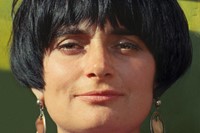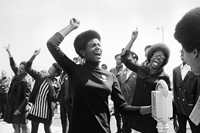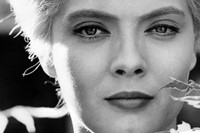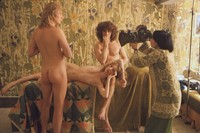As a new exhibition dedicated to her work opens in Paris, discover references behind five of the French director’s films – from second-wave feminism to art by Niki de Saint Phalle and Goya
The films of Agnès Varda – aka the “Grandmother of the New Wave” – have a distinct sensibility that is also hard to define: experimental but accessible; sensitive but direct; rooted in reality but also prone to fantasy and dreaming. While best known as a filmmaker, Varda, who was born in Belgium in 1928, is often described as having ‘three lives’: first as a photographer, then as a filmmaker, before moving towards visual art and installation at the end of her life. Her grounding in art history (she studied at the École du Louvre) was fundamental to her approach to filmmaking; from Velázquez to Dalí, her films gorgeously reference and reinterpret paintings from the art historical ‘canon’. Yet Varda’s magpie sensibility is a mosaic of references to magazines and photography as well as literature, music and popular culture.
During her 70-year career, Varda was constantly developing – particularly in the way she responded to technological developments and changing social issues – from the civil rights movement (in Black Panthers) and second-wave feminism (too many films to list) to environmentalism (in The Gleaners and I). As the new exhibition Viva Varda! opens at the Cinématheque Francaise, shedding light on the story of Varda’s career, AnOther looks back at the cultural and artistic references behind five of her major films.
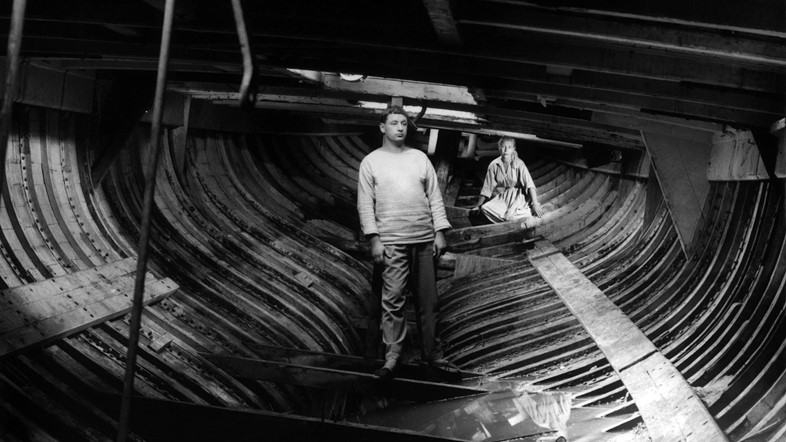
La Pointe Courte, 1954
For her first film, Varda returned to Sète, a coastal town in the south of France where the director escaped to with her family during the war. ‘La pointe courte’ refers to the specific geography of the fisherman’s quarters. Yet the dual structure of La Pointe Courte – a couple’s matrimonial difficulties and the plight of fishermen – was inspired by William Faulkner’s 1939 novel Wild Palms. At the time she made the film, the 26-year-old photographer had allegedly only seen one film, Citizen Kane. “I didn’t know much about cinema,” she said. “So it seemed to me that many “literary revolutions” hadn’t had their equivalent on screen. I was inspired by Faulkner and Brecht in trying to break down narrative constructs, in finding a tone that was at once subjective and objective, giving the spectator freedom to judge and participate.”
La Pointe Courte demonstrates Varda’s photographer’s eye for images – white laundry drying in the wind, baskets of shells and kittens curled up in the sun. These domestic images have Gaston Bachelard’s philosophies of intimate space all over them, which Varda studied at the Sorbonne. Some of the references in La Pointe Courte are incidental. When director Alain Resnais compared the film to Luchino Visconti’s neorealist masterpiece, La Terra Trema (1948), about a Sicilian fishing village, as well as Michelangelo Antonioni for its depiction of a couple’s existential crisis, Varda responded: “who?”. Her decision to overlay the couple’s faces was a trope pioneered by Ingmar Bergman, yet the cinephobic Varda was more likely influenced by the Cubist composition of Picasso.

Cléo from 5 to 7, 1962
Varda’s second feature film, Cléo from 5 to 7, does what it says on the tin, depicting two hours in the life of popstar Cléo Victoire as she waits for the results of a medical exam that will determine whether she has cancer. Varda’s starting point for the film was German painter Hans Baldung’s Death and the Maiden (1517), an allegorical work in which a porcelain-skinned woman is reminded of her mortality by a skeletal, grim reaper figure. Swapping the German Renaissance painting for the iconography of popular women’s culture, in the opening scene, Varda shows Cléo at a tarot reading where she is handed the card of death.
While not based on any figure in particular, the conventionally beautiful Cléo, with her blonde hair and feminine clothing, resembles yé-yé stars such as Brigitte Bardot and Sylvie Vartan, alternatively sexualised and infantilized by male producers and songwriters. Thrown into crisis by the test, Cléo cloaks herself in black and walks through the streets of Paris. Moving away from her narcissistic identity as fetishised muse, she takes on the more masculine guise of the flâneur – as popularised by poet Charles Baudelaire and Walter Benjamin – taking in the city as if for the first time. The spectre of the Algerian War (1954-1962) – of which we hear news on the radio – is another key reference point for Varda. Cléo meets Antoine, a chatty soldier waiting to return to the front. With Antoine also on ‘borrowed time’, Cléo’s cancer becomes a metaphor for colonial violence.
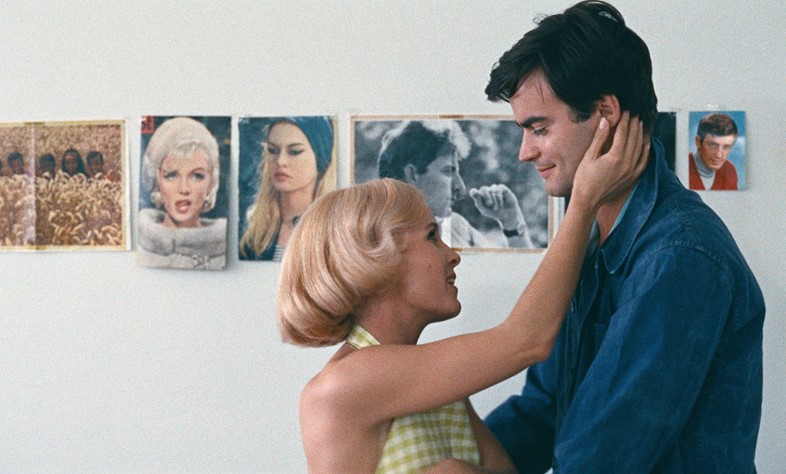
Le Bonheur, 1965
A lifelong feminist, in the early 1960s Varda became actively involved in the second-wave feminist movement, whose key work of literature, Simone de Beauvoir’s The Second Sex , had been published in France in 1949. De Beauvoir, like Betty Friedan 13 years later in The Feminine Mystique, saw women as secondary to men, relegated to a life of domestic drudgery, without independent aspirations. Varda’s 1965, Le Bonheur, about a nuclear family in suburban France, is Varda’s own meditation on the limits of heterosexual conjugality. The ‘happiness’ of the title is intended as a provocation. Shot in sunkissed, hyper-saturated hues, at first the central couple François and Thérèse seem to have it all. Yet when François starts an affair with a post office worker who looks almost identical to his wife, this dream turns into a waking nightmare (for Thérèse in particular).
As suggested by the impossibly bright cinematography, Varda wanted to expose the falsity of the dream sold by catalogues and French women’s magazines such as Elle. ‘Action’ shots of Thérèse – ironing, cooking and sewing – seem to be taken straight from their pages. Rather than actual adverts, however, a clip on the family’s television shows Jean Renoir’s Picnic on the Grass (1959). As a hybrid of pastoral and social satire, Renoir’s film was a key influence on Varda.
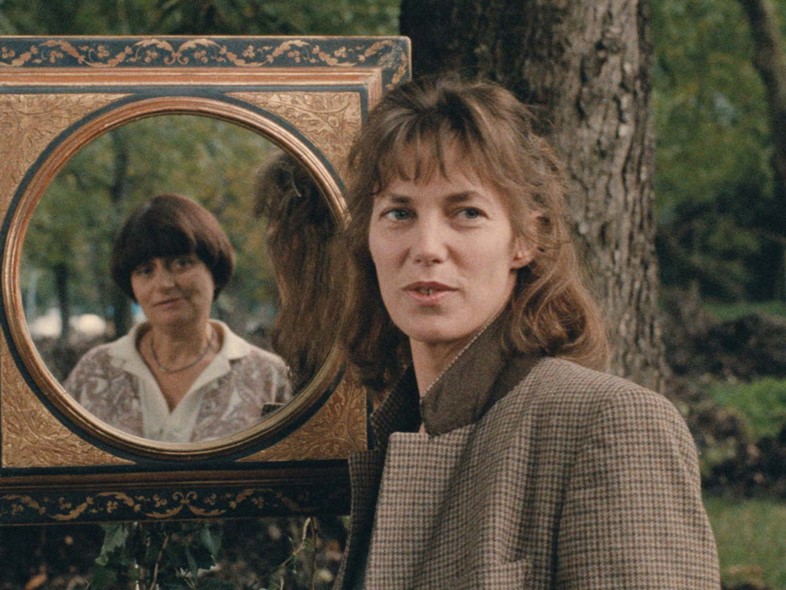
Jane B by Agnès V, 1988
After watching Varda’s Vagabond (1985), Jane Birkin wrote the director a letter to tell her how much she had enjoyed it. “She responded to say my handwriting was terrible, and arranged to meet me in the Parc de Sceaux so I could read it to her!” recalls Birkin. The rendez-vous resulted in Jane B by Agnes V, a “kaleidoscope portrait” of the actress, at this point an institution in France and beyond. Varda steers clear from any fixed idea of Jane as a muse, drawing on an extensive body of references to show Jane as she ‘is’. In a tableau vivant of Titian’s Venus of Urbino, we see Jane recline in jeans and converse. Then undressing and then dressing her in costume, Varda references Francisco Goya’s paintings Maja Desnuda and Maja Vestida. Other guises for Birkin include the servant in the back of the painting; a cockney mother; Laurel of Laurel and Hardy; a murderous money-grabbing lover and the Ariadne of Greek mythology in her maze.
Varda’s portrait – made on the occasion of Birkin’s 40th birthday – duly focuses on the actor’s vulnerability and feelings of transience, while seeking to capture a beauty beyond the male gaze. Birkin wanders along a beach filled with Niki de Saint Phalle’s famous Nana sculptures (“They don’t need men, they are free, joyful.”) Varda compares her portrait of Birkin with The Mystery Woman of the Seine: a corpse retrieved from the river, with such a beautiful face with “a smile as enigmatic as the Mona Lisa” that death masks were made of her. “I wonder if the only true portrait is the death mask,” she muses.

The Gleaners and I, 2000
After almost a decade away from directing, Varda made her comeback with The Gleaners and I. In the opening scenes she heads to the Musée d’Orsay in Paris where she looks at Jean-François Millet’s painting The Gleaners, in which peasant women gather stray stalks of wheat after the harvest. Varda’s documentary explores gleaning in its manifold expressions, creating a tender, moving portrait of those who glean in France today, both through necessity and pleasure, insisting on the legality and dignity of the gesture. Made at the turn of the millennium, the film is timely, a profound critique of our hyper-consumerist capitalist society which allows so much to go to waste, while also leaving certain people by the wayside.
Varda puts herself in a tableau vivant of Jules Breton’s 1875 painting The Gleaner. Establishing herself as the film’s second ‘glaneuse’, she puts down a bundle of hay to pick up her camera. For Varda, filming is also an act of gleaning. Varda praises her new lightweight camcorder which allows her to film on the move, to collect subjects as and when she finds them. A road movie, that sees the director voyaging up and down France, Les Glaneurs bears the fingerprint of Marguerite Duras’s 1977 The Lorry, an experimental film about a driver’s lonely journey through the night. Varda films herself trying to ‘capture’ the trucks she sees on the motorway with her hands; “to hold on to that which passes.”
Viva Varda! is on show at the Cinematheque in Paris until 28 January 2024.

